| Rupununi uprising | |||||||
|---|---|---|---|---|---|---|---|
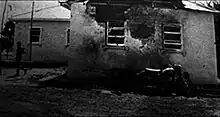 Damage to the Lethem police station from rebel bazookas | |||||||
| |||||||
| Belligerents | |||||||
|
| |||||||
| Commanders and leaders | |||||||
|
Valerie Hart Elmo Hart James Hart Averrel John Melville | |||||||
| Strength | |||||||
| 200 soldiers[1] | 120–300 rebels[2] | ||||||
| Casualties and losses | |||||||
|
| ||||||
The Rupununi uprising was a secessionist insurrection in Guyana that began on 2 January 1969 led by cattle ranchers[4][5] who sought to control 22,300 square miles (58,000 km2) of land.[2] Occurring less than two years after Guyana’s independence from the United Kingdom, it constituted the country’s earliest and most severe test of statehood and social solidarity. The rebels were ultimately dispersed by the Guyana Defence Force, with the group's leaders fleeing to Venezuela.[4][5]
Background
Guyana–Venezuela relations
.png.webp)
Venezuela was reported to have supported and sponsored the Rupununi rebels and their secession movement.[2][6][7][8][9][10][11][12][13] According to Taylor, "Guyana faced a serious external threat from its much larger neighbor, Venezuela, which was pressing its historic claim to two-thirds of Guyana, the area west of the Essequibo River", further stating that while the Guyana Defence Force had 750 soldiers with no navy or aviation units, the Venezuelan Armed Forces had 15,000 troops along with a well-functioning air force and navy.[11]
Shortly after Guyana achieved its independence from the United Kingdom and the departure of the British Armed Forces in May 1966, Venezuela began to encroach on Guyana's territory, with Venezuelan troops capturing and occupying Ankoko Island in October 1966.[6][11][14][15] In 1967, reports emerged that Venezuela was enacting economic warfare against Guyana and later in the year, a British national was expelled from Guyana for provoking indigenous groups to support Venezuela territorial claims.[14] Venezuela then made claims in August 1968 that territory two miles to the east that spanned from the Amacuro River to the Essequibo River.[14] Simultaneously with its other actions, Venezuela launched a propaganda campaign to support its claims that included "hints of a developing revolutionary war against Guyana" according to Rau, with Venezuelan diplomat Carlos Perez DeLaCova saying in a letter to The New York Times that Venezuelans were "victims of British expansionism, and Guyana is the heir and beneficiary of that encroachment on our territory."[14]
According to Jackson, Venezuela established "Amerindian subordination and displacement" by arguing that indigenous peoples were not present in certain areas and demanded that Spain's own imperial claims were to be respected.[16]
Ranch leaders
The rebellion was primarily led by ranch heads who thought their land rights would be revoked by the new Guyanese government following the 1968 Guyanese general election.[3] The Hart family was one of the main groups organizing the plot.[4][17][18] Valerie Hart, a United Force politician, her two brothers, James and Elmo, and two Americans named Harry and Richard Lawrence, also led the rebellion.[5] Another participant was Clement Tezarik, son of a Czechoslovakian miner.[5]
Motives for the rebellion are divided. The New York Times wrote in 1969 that rebellion was led "cattlemen in the Rupununi area who objected to the Negro-dominated Government of Prime Minister Forbes Burnham."[19] The Guyanese government accused the uprising leaders of forcing and misleading the region's indigenous people by saying that the government would take their land.[4][17][20] Guyanese Agriculture Minister Robert Jordan declared that the government would not recognize the inhabitants' land ownership certifications and warned that the zone would be occupied by the African American population.[21] After the rebellion, James Hart would cite the declaration as a reason for the uprising, saying that the Guyanese government denied the ranchers a 25-year lease request for the land they occupy and feared that farmers arriving from Jamaica and Barbados would take their land,[3] saying that they opposed the transfer of frontier farmlands and gold and diamond mining areas from the indigenous people to African-Guyanese and Indo-Guyanese.[17] The Guyanese government was in the process of creating a commission for issuing land certificates to indigenous families in the area, though the review of 20,000 square miles (52,000 km2) of land was required.[17]
According to Valerie Hart, a United Force politician, the region's population rebelled against the government because their constitutional rights were not respected and because of continuous intimidation and repression directed against them.[9] Valerie was present at the First Conference of Amerindians Leaders, named the "Cabacaburi Congress" in 1968, presenting demands to Burnham who represented the community of around 40,000 indigenous people of the Rupununi district.[22] The movement, according to Venezuelan Navy officer Pedro González Caro, defended the integration of natives to Guyanese society, inconsonant with Burnham's afrocentrist policies.[9] Sanders instead said that the rebellion "was not an Amerindian rising, although many Rupununi Amerindians probably would have approved secession from Guyana."[23]
Events
Preparation
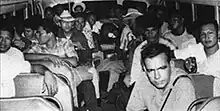
Planning for the rebellion involved a small group of 100 individuals in order to ensure secrecy.[24] The majority of Amerindians involved in the plot were employees of the ranchers.[2] The plan was to control the Rupununi region for three days, which plotters assumed would result with recognition from Venezuela.[24]
Venezuelan media reported that the rebellion was reportedly assisted by Democratic Action so that Venezuelan president Raúl Leoni would not have to transfer power to president-elect Rafael Caldera of the Copei party.[2] According to Venezuelan media, military personnel linked to Copei were dismissed from their positions in November 1968.[2]
At a 23 December 1968 meeting, rebels finalized plans of a separated Rupununi state.[25] Reports from various sources, which one rebel named Colin Melville corroborated, said that Venezuela provided training to rebels, flying them into its own territory for exercises on how to use bazookas and machine guns.[14][17] An aircraft of the Venezuelan Army was reported to have flown to the northern territory of Rupununi, landing in the savannah to pick up forty rebels and transporting them into Venezuela for a week of training before being flown back to the Hart family ranch in Pirara on 1 January 1969.[2][25] According to the Guyanese government, rebel forces were flown to Santa Elena de Uairén on 24 December 1968, bussed to Santa Teresa the next day where they flew two hours to a military camp for training.[2] Images of rebels on buses in Venezuela being transported to training facilities were also released following the rebellion.[2] According to Copei officials, a plane used to transport rebels belonged to the State of Bolívar, whose governor allied with Democratic Action in the plot, with the plane being captured by Brazilian authorities after rebels fled into Brazil.[2] Evidence was also shared that Venezuela provided rebels with modern equipment.[17]
The Guyanese government said that Valerie was provided facilities in Venezuela where she could make radio broadcasts promoting her movement, asking for aid from individuals from the United States.[4][2] In an effort to receive support from Venezuela, Valerie and her rebels stated that they would grant Venezuela control of Guyana's disputed Guayana Esequiba territory in exchange for assistance.[26]
In March 2005, Venezuelan newspaper Últimas Noticias wrote that Venezuelan general Yépez Daga intended to lead soldiers and paratroopers to invade Guyana and assist rebels.[2]
Attack
Shortly after rebels reportedly returned from Venezuela, the operation was launched according to Ishmael.[2] Valerie stayed in the capital of Venezuela, Caracas, while her brothers and the Lawrences participated in the rebellion in Guyana.[5] The command center of the rebellion was at the Hart ranch, which was about 15 miles (24 km) from the town of Lethem, the principal settlement of the Rupununi region.[2] Rebels armed with machine guns and bazookas began their attacks on Lethem around 11:00am on 2 January 1969, first attacking a police station with about twelve officers present.[2] Five police officers – this included the constables James McKenzie, William Norton, Michael Kendall, Sergeant James Anderson and Inspector Whittington Braithwaite – along with two civilians, Victor Hernandez and Thomas James, were killed while the rebels destroyed buildings belonging to the Guyanese government with bazooka fire.[2][17][27][28] Three other individuals were reported dead, with The New York Times writing that a total of nine people were killed.[27]
The rebels locked citizens in their homes and blocked airfields in Lethem, Annai, Good Hope, Karanambo and Karasabai, attempting to block staging areas for Guyanese troops.[25] In Annai alone, around ninety individuals were locked in a slaughterhouse by rebels.[17] According to the Guyanese government, rebels looted tens of thousands of dollars after detaining residents.[2]
Counterattack
2 January
News about the insurrection reached Georgetown by midday on 2 January, prompting the deployment of policemen and soldiers of the Guyana Defence Force (GDF).[2][25] In the afternoon, a small group of police and GDF troops arrived at an open airstrip 5 miles (8.0 km) away from Lethem, being fired at by rebels upon their landing.[2][25] The night of the attack, the Hart family fled to Ciudad Bolívar, before going to Caracas to request military aid from the Venezuelan government; according to Valerie, her goal was, on behalf of the rebels, to create an independent region of Guyana.[29]
3 January
Venezuelan media outlets began to disseminate broadcasts on 3 January that indigenous groups were rebelling in Guyana and asking to be annexed by Brazil or Venezuela.[2] In the afternoon, Valerie Hart met in Caracas with the Venezuelan Foreign Affairs Minister Ignacio Iribarren Borges at the Yellow House, the headquarters of the Ministry of Foreign Affairs.[21] In an effort to obtain support, Valerie explained the uprising to Iribarren Borges and said that the rebels had the intention of ceding Rupununi to Venezuela.[2] Iribarren Borges said that Venezuela was bound to the 1966 Geneva Agreement with the United Kingdom and Guyana, and that Venezuela could not intervene in favor of the rebels even if it wanted to.[21] In a press statement following the meeting, Valerie would state "Venezuela must assert her rightful claim and not only the Rupununi but all the 50,000 square miles of territory of the disputed Essequibo region."[2] Valerie would go on to promote her cause with Venezuela's assistance, as official interpreters were provided at her press events.[2] Guyanese ambassador to Venezuela Eustace R. Braithwaite later questioned Borges on how Valerie was able to illegally land a private aircraft in Venezuela, immediately meet with Borges and then proceed to hold press events in Caracas; Borges responded saying that he was required to meet with Valerie, that she was personally aided due to humanitarian concerns and denied Venezuelan involvement.[2]
Eighteen hours after the first group of Guyanese troops arrived, a large group of GDF soldiers began their approach on Lethem.[2] As troops approached, the rebels quickly fled and the uprising ended.[25] As the towns of Annai and Good Hope were liberated from rebel groups, tied up policemen were tossed from trucks by dispersing rebel forces.[2]
4 January
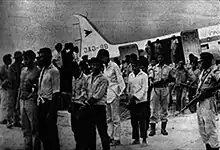
On 4 January, captain Edgar Gavidia Valero flew to Santa Elena de Uairén sent by the Venezuelan government with the orders that the Venezuelan military institutions had to unblock the airfields and start the evacuation of both the Amerindian population and the uprising leaders. Hours afterwards, Guyanese soldiers arrived at the area.[21] Burnham said in a radio broadcast to the public that day that the rebellion was the "beginning" and that Guyana "must therefore expect further acts of aggression and intimidation from the new imperialism on our western doorstep", describing the rebels as "terrorists" trained by the Venezuelan army.[4][2]
Fighthing continued in Annai,[17] and by the end of the day the Guyanese government reported that it had defeated the rebellion.[20]
Aftermath
Members of the failed uprising fled to Venezuela for protection after their plans unravelled, with Hart and her rebels being granted Venezuelan citizenship by birth since they were recognized as being born in the Guayana Esequiba disputed territory.[9][30]
Criminal charges
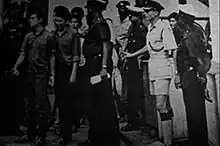
About thirty of the rebels were arrested following the uprising.[28] Guyana charged fifty-seven individuals with murder.[3] Of the twenty eight rebels arrested, eighteen were released on 24 January 1969 after having murder charges dropped.[20][31] The ten remaining individuals were Anaclito Alicio, Ignatius Charlie, Charles Davis, Francis James, Colin Melville, Patrick Melville, Damian Phillips, Aldwyn Singh, Brenton Singh and Handel Singh.[2][3]
During a jury trial in late 1969, Guyanese prosecutors presented evidence of Venezuelan armaments and oversight of the rebels, though the defense for those accused argued that his clients were under duress when they participated in the rebellion.[2] On 16 January 1970, the verdict of the jury was determined after seven hours of deliberation; seven of the ten accused were found not guilty while a verdict was not presented for Aldwyn, Colin and Patrick.[2] The judge overlooking the trial order a retrial, though the three remaining individuals were later acquitted and released.[2]
Political responses
Venezuelan Interior Affairs Minister Reinaldo Leandro Mora stated that some Guyanese individuals were provided military training in Venezuela after being encouraged by their family members.[2][25] Guyanese minister Ptolemy Reid said that Mora's admission that Guyanese individuals being militarily trained in Venezuela and illegally transported between the two nations was further evidence of Venezuela's involvement.[2] The minister also said that individuals displaced as a result of the conflict were "a zone that is considered Venezuelan and are being persecuted", that they would be provided jobs and that such individuals would be awarded land.[2][25] The ranchers who organized the rebellion were settled into the Gran Sabana region by the Venezuelan government.[3]
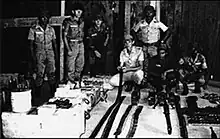
Prime Minister of Guyana, Forbes Burnham, said during a meeting with prime ministers of the Commonwealth of Nations on 5 January that Guyana would present a denunciation against Venezuela to the United Nations.[4][2] On 6 January 1969, Valerie was expelled from United Force, with the party saying that she was involved "with the rebellion and plot by a foreign power."[20]
The Ministry of Foreign Affairs of Brazil released a statement in support of Guyana on 7 January, saying Brazil "has expressed to the Guyanese government in this difficult moment its belief that this bordering and friendly nation will completely overcome the movement that disturbs its internal security and menaces its territorial integrity."[2]
According to a Reuters report on 8 January, Valerie Hart stated "If Venezuela does not intervene right now with troops they would have in their hands a situation similar to the Bay of Pigs", comparing Venezuela's reported abandonment of rebels to the United States' refusal to support Cuban Democratic Revolutionary Front forces.[2]
The Guyanese ambassador to the United Nations presented its official letter to Secretary-General of the United Nations, U Thant, on 9 January 1969, saying "The government of Guyana is now in possession of irrefutable proof that the individuals who organized and carried out those crimes were trained for the purpose within the territory of the Republic of Venezuela, and supplied with arms by authorities of the Republic of Venezuela."[2]
On 20 January 1969, Valerie Hart met with exiled rebels in Ciudad Bolívar to encourage them to maintain their fighting.[2]
In March 1969, Guyana instituted a three percent fee on imports to fund defense spending in response to the incident.[19] Meetings between Burnham, 160 Amerindians and all Amerindian chiefs (touchaus) held from 28 February to 3 March 1969 resulted with indigenous groups present condemning the actions of Venezuela, with the touchaus declaring in a joint statement that they pledged loyalty to Guyana, that they will never accept Venezuelan territorial claims and that they condemned individuals who collaborated with foreign nations.[2][25]
At a United Nations meeting on 7 October 1969, Venezuelan ambassador Andrés Aguilar denied allegations that Venezuela assisted rebels and threatened potential investors in western Guyana that if they were to achieve land titles or agreements with the Guyanese government, that Venezuela would not recognize them if the territory were to be reclaimed.[32]
Into 1970, the Venezuelan government continued to promote anti-Guyana sentiment to its citizens.[14] After the uprising, Venezuela President Rafael Caldera and Burnham were alarmed at the uprising and vowed to focus their attentions on the issue of the territorial dispute between their two countries, leading to the Port of Spain Protocol in June 1970.[9]
Reports of abuses
Venezuela and Indigenous activist groups accused Guyanese forces of attacking and killing Amerindians in the region.[2] According to Sanders, "reliable sources" reported two or three Amerindians killed and said that accusations that up to seventy deaths occurred were "rumors."[3] The Guyanese government and its authorities denied any killings.[2]
A pilot of the Guaica airline, who stayed at Lettem, said two C-47 planes landed, Guyanese forces burned houses, tortured inhabitants and raped women.[33] Opposition leader Cheddi Jagan attempted to send two of his Amerindian personnel to the region in order to observe the situation but they were reportedly held at the airfield Lethem by GDF troops and flown back to Georgetown.[2] Bishop of Georgetown R. Lester Guilly traveled to the area and stated he witnessed no atrocities.[2] Some Amerindians relocated as a result of the rebellion,[3] with many moving to Brazil.[2]
See also
- Tigri Area, another territorial dispute involving Guyana
References
- ↑ , La insurrección de Rupununi.
- 1 2 3 4 5 6 7 8 9 10 11 12 13 14 15 16 17 18 19 20 21 22 23 24 25 26 27 28 29 30 31 32 33 34 35 36 37 38 39 40 41 42 43 44 45 46 Ishmael, Odeen (2015). The Trail of Diplomacy: The Guyana-Venezuela Border Issue (Volume Two). Xlibris. pp. 225–257. ISBN 9781503531284.
- 1 2 3 4 5 6 7 8 9 Sanders, Andrew (July 1972). "Amerindians in Guyana: A Minority Group in a Multi-Ethnic Society". Caribbean Studies. 12 (2): 31–51.
- 1 2 3 4 5 6 7 "Guyana Reports End of Uprising, Says Venezuela Aided Rebels". The New York Times. 6 January 1969. Retrieved 25 November 2023.
The government charge that the revolt had been led by wealthy cattle ranchers who coerced indigenous Indian peasants into supporting them
- 1 2 3 4 5 Times, Special to The New York (1969-01-12). "GUYANESE MAY TRY REBELS WHO FLED". The New York Times. ISSN 0362-4331. Retrieved 2023-11-30.
- 1 2 Griffith, Ivelaw Lloyd (2021-04-28). "New Dynamics in Northern South America's Geopolitical Neighborhood". Center for Strategic and International Studies.
- ↑ Mars, Perry (Summer 1984). "Destabilization and Socialist Orientation in the English-Speaking Caribbean". Latin American Perspectives. 11 (3): 95.
Perhaps the earliest incident of major consequence since independence (1966) was the Rupununi uprising in 1969 in which Venezuelan complicity was evident.
- ↑ Davis, Harold Eugene; Wilson, Larman Curtis (1975). Latin American Foreign Policies: An Analysis. Johns Hopkins University Press. pp. 191-196. ISBN 9780801816956.
- 1 2 3 4 5 González, Pedro (1991). La Reclamación de la Guayana Esequiba. Caracas.
{{cite book}}: CS1 maint: location missing publisher (link) - ↑ Black, Jeremy (2013). "Chapter 6: Wars Between Non-Western Powers, 1945-90". Introduction to global military history: 1775 to the present day (2. ed.). London: Routledge. ISBN 978-0415629201.
in 1969, the army and police in Guyana stopped a Venezuelan-backed secessionist rising in the Rupununi region
- 1 2 3 Taylor, Moe (2019). "Every Citizen a Soldier: The Guyana People's Militia, 1976–1985". Journal of Global South Studies. University of Florida. 36 (2): 279–311. doi:10.1353/gss.2019.0044.
In 1969, it was discovered that Caracas had backed a secessionist revolt by ranchers and Amerindians in the Rupununi region, ... To put this into perspective, when Guyana gained independence in May 1966, it had a standing army of 750 troops and no air or maritime forces. Venezuela, in contrast, had an army of 15,000, an impressive air fleet of British- and American-made jets and bombers, and a navy equipped with destroyers, frigates, and a submarine.
- ↑ Miline, R. Stephen (September 1974). "Impulses and Obstacles to Caribbean Political Integration". International Studies Quarterly. 18 (3): 308.
A Venezuelan incursion on the island of Ankoko (October 1966) and Venezuelan instigation of the Rupununi uprising (January 1969) were succeeded by an agreement signed on June 18, 1970, which provided that neither country would make any territorial claims for a period of at least twelve years.
- ↑ Cush, Ifa Kamau (13 August 2015). "Venezuela: A 'fishbone' in the throat of Guyana". New York Amsterdam News. p. 2.
In 1969, Venezuelan-trained and -equipped Guyanese secessionists declared an 'Essequibo Free State.'
- 1 2 3 4 5 6 Rau, Robert L. (April 1970). "The Venezuelan Border Dispute". Marine Corps Gazette. 54 (4): 42–43.
- ↑ Ince, Basil A. (1970). "The Venezuela-Guyana Boundary Dispute in the United Nations". Caribbean Studies. 9 (4): 5–26.
- ↑ Jackson, Shona N. (February 2006). "Guyana, Cuba, Venezuela and the "Routes" to Cultural Reconciliation between Latin America and the Caribbean". Small Axe: A Caribbean Journal of Criticism. 10 (1).
- 1 2 3 4 5 6 7 8 9 "GUYANESE TROOPS MOVE ON REBELS; Sons of U.S.-Born Rancher Said to Be in Group". The New York Times. 1969-01-05. ISSN 0362-4331. Retrieved 2023-11-30.
The Government charges that the ranchers have misled the Indians of the area into believing that the Government will take their land away and that they have pursuaded the Indians to support the rebellion
- ↑ David A. Granger (18 January 2009). "The Rupununi Rebellion, 1969". Stabroek News. Retrieved 7 December 2021.
- 1 2 "Guyana's New Budget Places 3% Levy on all Imports". The New York Times. 3 March 1969. p. 49.
- 1 2 3 4 "The Month in Review". Current History. 56 (331): 181–192. 1 March 1969. doi:10.1525/curh.1969.56.331.181.
- 1 2 3 4 "Guyana: De Rupununi a La Haya". En El Tapete (in Spanish). 4 July 2020. Retrieved 2021-03-13.
- ↑ Amerindian News Georgetown: vol 2, No 3, May 15th 1968.
- ↑ Sanders, Andrew (September 1987). "British Colonial Policy and the Role of Amerindians in the Politics of the Nationalist Period in British Guiana, 1945-68". Social and Economic Studies. 36: 93–94.
- 1 2 Sanders, Andrew (September 1987). "British Colonial Policy and the Role of Amerindians in the Politics of the Nationalist Period in British Guiana, 1945-68". Social and Economic Studies. 36: 93–94.
- 1 2 3 4 5 6 7 8 9 Braveboy-Wagner, Jacqueline Anne (2019). The Venezuela-Guyana Border Dispute: Britain's Colonial Legacy In Latin America. Routledge. ISBN 9781000306897.
- ↑ González, Pedro (1991). La Reclamación de la Guayana Esequiba. Caracas. pp. 14, 45–47.
{{cite book}}: CS1 maint: location missing publisher (link) - 1 2 "23 GUYANA REBELS FACE MURDER TRIAL". The New York Times. 1969-01-11. ISSN 0362-4331. Retrieved 2023-11-30.
- 1 2 Ishmael, Odeen (2013). The Trail of Diplomacy: The Guyana-Venezuela Border Issue. ISBN 9781493126552.
- ↑ GONZÁLEZ, Pedro. La Reclamación de la Guayana Esequiba. Caracas: Miguel A. García e hijo S.R.L. 1991.
- ↑ Briceño Monzón, Claudio A.; Olivar, José Alberto; Buttó, Luis Alberto (2016). La Cuestión Esequibo: Memoria y Soberanía. Caracas, Venezuela: Universidad Metropolitana. p. 145.
- ↑ "Guyana Releases 18 of 28 Accused in Recent Uprising". The New York Times. 1969-01-25. ISSN 0362-4331. Retrieved 2023-11-30.
- ↑ Orellana Yépez, Rosario (January–March 2001). "THE VENEZUELAN COMPLAINT ABOUT GUIANA IS A TEAM. CHRONOLOGICAL FOLLOW-UP". Bulletin of the National Academy of History. National Academy of History of Venezuela. 84 (333).
- ↑ Singh, Jai Narine (1 January 1982). Diplomacia o guerra: Análisis de la controversia fronteriza entre Venezuela y Guyana (in Spanish). Eduven. Retrieved 23 July 2015.